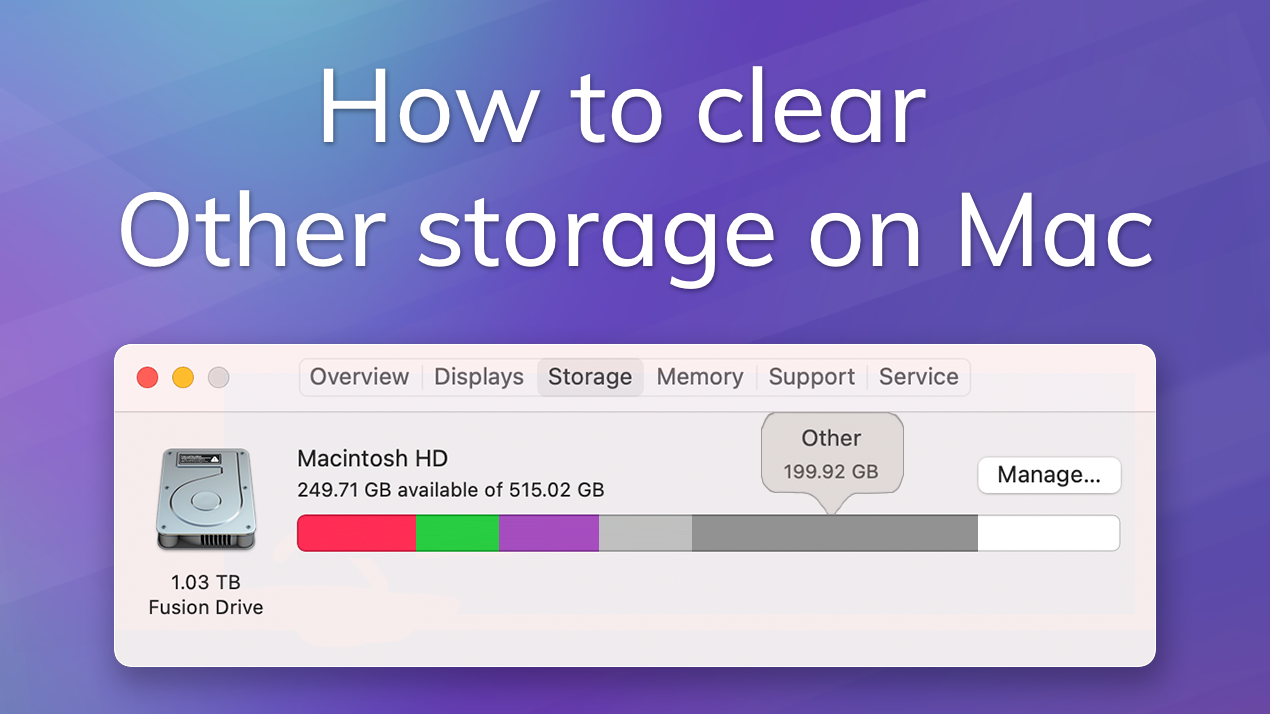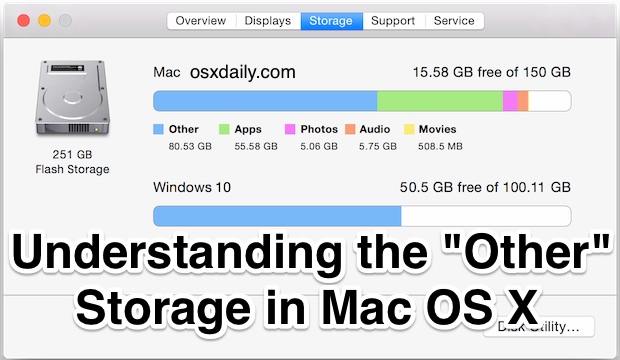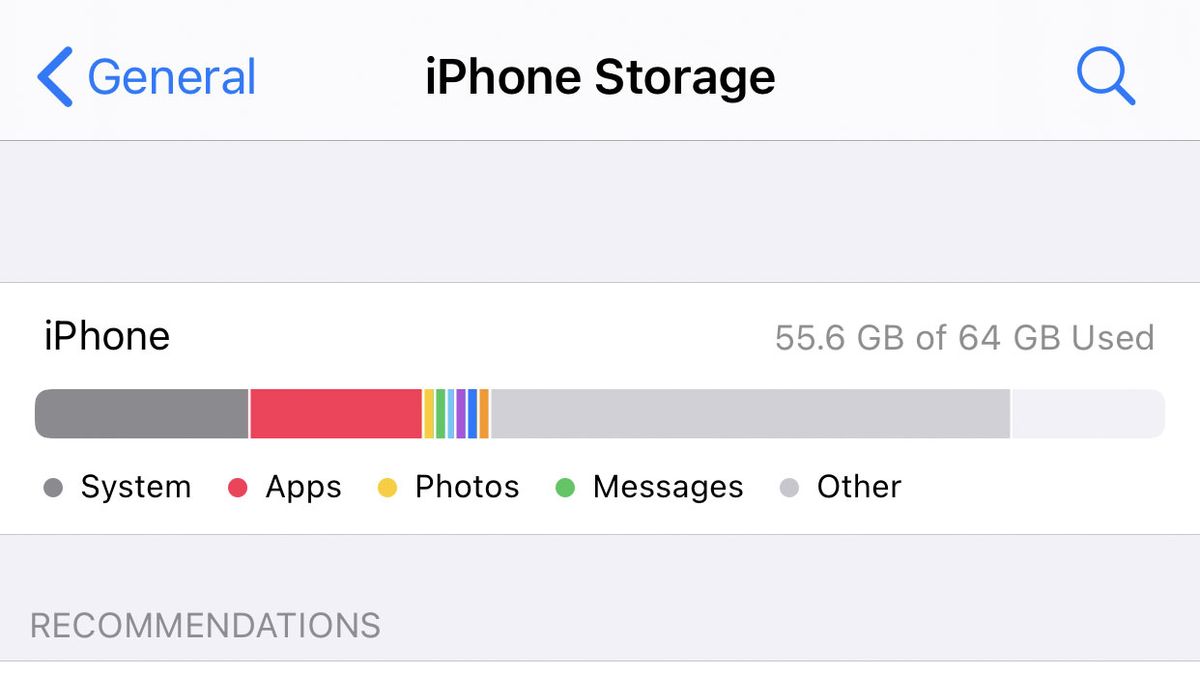Downloads Folder. The Downloads folder is the default location on Mac that stores all the content. Part 2: How to Delete Other Storage to Free Up Disk Space on Mac. After knowing what is Other on Mac storage, you need to take measures to delete Other storage on Mac. It is impossible to entirely get rid of Other on Mac. But you can clean up your Mac Other storage in multiple aspects. It is true that you can find and delete each Other file. Jul 21, 2021 The Storage pane of About This Mac is the best way to determine the amount of storage space available on your Mac. Disk Utility and other apps might show storage categories such as Not Mounted, VM, Recovery, Other Volumes, Other, Free, or Purgeable. See full list on mackeeper.com.
- How To Free Up Other Storage On Mac Laptop
- How To Increase Laptop Storage
- How To Free Up Other Storage On Mac
After drinking your first cup of coffee, it is time to start your day with your computer. However, the popping-up message says “Your disk is almost full”. You need to optimize storage to save space on Mac. The dreadful Mac storage is almost full message make you realize that how much stuff stored on your Mac. Well, you may get shocked that “Other” takes up the most storage space.
What is Other on Mac storage? It is easy to understand about “Audio”, “Movies”, “Photos”, “Apps” and “Backups”. But what does “Other” mean in Mac storage? Is there any way to clean up Other storage on Mac? Luckily, you can figure out what is Other storage on Mac and how to remove files from Other storage in details here.

- Part 1: What You Need to Know about Other Storage on Mac
- What Is Other on Mac Storage
- How to Check Other Storage on Mac
- Part 2: How to Delete Other Storage to Free Up Disk Space on Mac
- 1. Remove Unwanted Documents to Free Up Other Storage on Mac
- 2. Delete Cache Files in Other Mac Storage
- 3. Clear Large Files and Folders to Clean Up Mac Other Files
- 4. Clean Up App Plugins and Extensions from Other on Mac Storage
Part 1: What You Need to Know about Other Storage on Mac
Let’s solve the first question together. What is Other storage space in Mac OS X? Which category should Other belong to? Just read and get your answer.
What Is Other on Mac Storage
Generally speaking, all Mac files that cannot be divided into “Apps”, “Photos” and other categories are Other files. These are some data types that are stored in Other storage on Mac.
- System and temporary files about macOS, like logs, preferences files and more.
- Cache data from browser, apps, photos, system, etc.
- Documents in pdf, doc, psd, csv, etc.
- Personal information.
- Browser history, cache, downloads and more.
- Archives and disk images in zips, dmg, iso, tar, etc.
- App support, app accessories, iCloud files, screen saver, fonts, updates and other file types not recognized by Spotlight.
How to Check Other Storage on Mac
Part 2: How to Delete Other Storage to Free Up Disk Space on Mac
After knowing what is Other on Mac storage, you need to take measures to delete Other storage on Mac. It is impossible to entirely get rid of Other on Mac. But you can clean up your Mac Other storage in multiple aspects. It is true that you can find and delete each Other file manually. If you want to get a quicker way to clear Other storage on Mac, Aiseesoft Mac Cleaner is your first choice. You can download the free version from its official site.
1. Remove Unwanted Documents to Free Up Other Storage on Mac
Way 1: Manually Delete Other Documents on Mac
Way 2: Quickly Delete Large and Old Files from Other
2. Delete Cache Files in Other Mac Storage
Way 1: Manually Delete Cache files from Other Data Storage
Way 2: Quickly Delete User Cache Files to Free Up More Space
3. Clear Large Files and Folders to Clean Up Mac Other Files
Way 1: Manually Delete System and Temporary Files from Other on Mac

Way 2: Quickly Clean System Files and Logs from Other Storage Space
4. Clean Up App Plugins and Extensions from Other on Mac Storage

Way 1: Remove Extensions and Plugins from Safari
Way 2: Remove Extensions and Plugins from Google Chrome
Furthermore, you can also use the built-in app uninstaller, duplicate finder, file manager, unarchiver, file hider, system performance monitor and more here. In a word, you can delete Other on Mac and speed up Mac in clicks. Mac Cleaner is 100% safe to use. You can preview, filter, organize and select any Mac file before cleanup. The whole process will not cause data overwritten. You will never know how fast your Mac computer can be before running Aiseesoft Mac Cleaner. Well, why not free download the program to have a try right now!
What do you think of this post?
Excellent
Rating: 4.5 / 5 (based on 103 votes)Follow Us on
- What Is the Other on My iPhone and How to Clear Other Data
What is the other on my iPhone? How to clear other space from iPhone? Many of you have the same questions. Read this post and find the answers.
- How to Uninstall Programs on Mac
How do I uninstall a program on Mac? Learn how to remove a program from Mac from this page.
- How to Check and Clean up Disk Space on Mac
How to access and free space on Mac? You can learn how to clean up disk space on Mac from this page.
/Mac Cleaner /What is Other on Mac Storage and How to Remove It
I’m a loyal MacBook user; so loyal, that I’ve bought my 4th MacBook now. I replace them with new ones every time I want to. I’ve been using my 4th Mac for 2 years now. I noticed that mac other storage is growing and is running out of the application memory of my system. There're 50GB of 'other' on Mac! How to delete other storage on Mac 2020 to free disk space and to make it perform faster?
It's easy to clean up other storage on Mac. In the following, we'll show you how to get more disk space for your Mac.
Article GuidePart 1. What Is Other on Mac Storage?Part 2. How Do I Get Rid of Other Storage on My Mac?Part 3. How to Manage Storage on Mac?In Conclusion
Part 1. What Is Other on Mac Storage?
Is your Mac running slowly? Have you checked out the storage capacity of your Mac device? It has various labels right? You can see Apps, Audios, Movies, Photos, as well as Backups. Everything seems to be obvious, isn’t it? You know which files are actually eating up your disk space.
But how about “Other”? What does this mean? It can be frustrating to know that these “Other” files take too much of our disk space so that we have to free them. Want to get the actual storage space back? Well, we’ll tell you more about Other Storage first. And then, we’ll tell you how to get rid of other storage (purgeable space) on your device.
What is Other on Mac storage? Other types of storage refer to those that do not fit in the categories (e.g. Apps, Audios, Movies, Photos, as well as Backups). These Other files would include the following:
- Documents including .doc, .PDF, and .psd files.
- System files of macOS X.
- Temporary files of macOS X.
- Cache files including browser cache, user cache, and system cache.
- Disk images.
- Archives including .dmg and .zip.
- App plugins.
- Extensions.
- Everything that cannot be classified into the main categories.
Then, how to delete other storage on Mac 2020 when Mac other storage is huge? Let's move into the following parts of deleting Mac other storage, especially with a free-tried and powerful Mac cleaner.
Part 2. How Do I Get Rid of Other Storage on My Mac?
How to access other storage on Mac? How to delete other from Mac? You don't know how to delete Other storage on Mac (2020) completely because it might contain files that are important. What we would do to help you is to delve into different types of Other files and how to clean them.
# 1 - Removal Of Documents That Take Up Other Storage Space
You might think that documents do not take up too much storage space. But you’ll realize later that .csv and .pages files can actually be large in size. And that’s just it. We’re not even counting images, big presentations, and eBooks. That’s why your Other storage takes up too much space.
Here’s a step-by-step guide on how to clean other on Mac by clearing documents:

- Go to your desktop, then press
Commandand F keys together. - Press This Mac then press the 1st dropdown menu field.
- Choose Other.
- Go to the Search Attributes window to tick up File Size and File Extension.
- You now have the ability to place various file types of documents (e.g. .pages, .pdf, .csv, etc.). You can also input file sizes in order to locate large documents.
- Review the results (or items).
- Delete files you no longer need.
# 2 - Deleting Temporary Files
When your Mac is currently running, it always creates (and even piles up) system files such as logs. These files are necessary for the system to function normally--only on a specified period of time. There are times that these files become outdated and result in clogging up of your disk space. These are part of the Other classification as well.
Usually, these type of files is temporary. But sometimes, they don’t get removed unless you actually do something about them. Apple didn’t make it easy for you to delete these system files and temporary files.
So, where can you find these system files? Follow the steps below on how to clear system storage on Mac:
- Go to
~/Users/User/Library/Application Support/ - In the folder that appears, you will see applications that use up too much space with their temporary files and system files.
- Delete this manually.
However, this is not a recommended way to delete other storage on Mac 2020. Why is this so? Well, you might delete files that are necessary for the apps to function. The best way to do this is to use iMyMac PowerMyMac, which can help you to delete other from Mac by removing your Mac junk files including unnecessary documents, temporary files, caches and others. Have a free trial below!
# 3 - Removing Cache Files
Cache files look harmless to you. But they can actually take up much disk space. There are three types of cache (the main ones)--- user, browser, and system. These cache files are used to improve the speed of your system. But once they get really big, it can turn the other way around resulting in poor system performance.
Here’s how to clear cache files manually on your Mac device:
- Go to Go > Go To Folder.
- Type out
~/Library/Caches, then press Go. - Click-hold Option. After which, drag the folder of Caches towards your desktop. This serves as a backup of your cache which you can restore if something happens.
- Select every file located inside the Caches folder.
- Drag these files towards the Trash.
- Finally, you have to Empty the entire Trash.
Do the same steps all over again. However, in step 2, type out /Library/Caches to clear up more cache in another folder.
Do steps 1 to 6 all over again. However, in step 2, type out ~/Library/Logs to clear out other types of cache again.
If you are worried that you might delete necessary files, you can use PowerMyMac again.
# 4 - Removal Of Disk Images And Archives
If you have unnecessary .zip, .dmg, and .rar files, among others that take up system storage, you should clean them up immediately to free your disk of storage space.
You can find them by utilizing the Spotlight search:
- Launch Finder.
- Type out
DMG/ZIP.Type this within the search field. - Choose Search: This Mac.
- The results will be displayed and sort these files by size.
- Clean the files you don’t need, especially the large-sized ones.
Tip: PowerMyMac's Large & Old Files can help you find out and remove archives quickly and easily.
# 5 - Removal Of Application Plugins and Application Extensions
Sometimes your memory is fulled of applications. Add-ons and plugins of your applications are included in the Other Storage category (as opposed to the Apps category). These don’t take up much space. However, it’s still worth clearing them out to gain more space.
Extensions sometimes cause trouble to your Mac device and it is best to remove them. This is a double whammy! You get to remove the app logs that cause trouble and you get to free up space too. You can manually remove these extensions one-by-one to delete other storage on Mac 2020.
How to remove your Safari extensions:
- Open browser named Safari.
- Press Preferences.
- Press the tab labeled Extensions.
- Choose the extension you want to delete. Uncheck “Enable” in order to deactivate it.
- If you want to delete it, click Uninstall to uninstall Safari.
How to remove your Chrome extensions:
- Launch Chrome.
- Click the icon appearing like three dots. This is located in the top-right corner of the browser.
- Press More Tool.
- Press Extensions.
- Remove or disable extensions depending on what you want.
How to remove extensions from Firefox browser:
- Launch Mozilla Firefox.
- Find the burger menu and open it. This is located in the top-right corner of the screen.
- Select Add-ons.
- Look at the Extensions and Plugins tabs.
- Remove or disable any extension or plugin you want.
Note:
If you are unsure of the use of a specific extension or plugin, do not delete it. You should disable it first. If your apps (or your system) works fine after you have disabled a specific extension (or plugin), THEN you can remove it. PowerMyMac also gives you a hand to manage all the extensions in different browsers at one time.
Here’s how to do it step-by-step with this tool:
- Download and Launch PowerMyMac
- Click Extensions under the Toolkit module.
- Click Scan. Results will show a list of extensions on your Mac.
- Find the extensions or plugins you want.
- Toggle to disable these extensions or plugins.
# 6 - Removing Everything Else That Cannot Be Classified
Mac Other Storage Space has its own Other classification. Funny, right? These files can actually include the following:
- Files located within your user library (e.g. screensavers)
- Files that cannot be recognized by Spotlight search.
Typically, these Other Files do not take up a lot of space. But, as you might know, a little goes a long way. If you want to clean up screensavers, here’s how to do it:
How To Free Up Other Storage On Mac Laptop
- Launch Finder to locate Menu Bar.
- Choose Go > Go To Folder.
- Type out:
~/Library/Screen Savers, then press go. - Delete these screensavers.
Files not recognized by Spotlight are rarer. They include different files such as partitions of Windows Boot Camp. They can also include hard drives of virtual machines.
Part 3. How to Manage Storage on Mac?
Although you have known the ways on how to delete other storage on Mac 2020, but it's better for you to manage storage on your Mac, at this case you must consider Storage feature of macOS.
You can click Storage > Manage > Recommendations tab to find Store in iCloud, Optimize Storage, Empty Trash Automatically and Reduce Clutter options that can manage your Mac storage.
With Store in iCloud, only your current files and optimized images would be stored in iCloud. And only if you need these files will iCloud download them for you. Thus, you can save more storage space.
When using Optimize Storage, you can see all the purgeable categories in the storage details. Then you can selectively manage some big files like iTunes movies or other big attachments.
You can set automatically delete items from Trash on Mac after your 30-days saving via Empty Trash Automatically: go to Finder>Preferences>Advanced, then you can see 'Remove items...', just tick that box.
Reduce Clutter aims to remove the junk files that you don't use anymore to free up more space on Mac: Review Files > choose unwanted apps or files shown in the new window > delete those apps or files.
How To Increase Laptop Storage
In Conclusion
Mac Other Storage can actually take up too much space and make your system slower. If you want to speed up your device performance, you can clean up unnecessary Other Storage files manually.
Of course, we recommend you delete other storage on Mac 2020 automatically with a fantastic tool iMyMac PowerMyMac, and you will find it really helps you a lot!
ExcellentThanks for your rating.
Rating: 4.5 / 5 (based on 96 ratings)
People Also Read:
How To Free Up Other Storage On Mac
PowerMyMac
A powerful all-in-one App for Mac
 Free Download
Free DownloadKun2019-01-05 11:24:05
Yeah i am a writer so there are a bunch of documents, it's time to say bye bye to them! cheers!
Wilisa2018-11-29 05:23:20
Lots of caches hidden in Other Storage...thanks, have removed all
Clean up and speed up your Mac with ease
Free Download